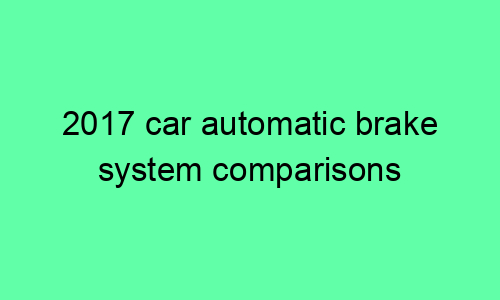2017 Car Automatic Brake System Comparisons
Introduction
Automatic brake systems are increasingly becoming standard on new cars. These systems use sensors to detect when a collision is imminent and automatically apply the brakes to prevent or mitigate the impact. As a result, they can play a significant role in reducing the number of accidents and injuries on the road.
How Do Automatic Brake Systems Work?
Automatic brake systems use a combination of sensors, including radar, cameras, and lasers, to monitor the vehicle’s surroundings. These sensors can detect objects such as other vehicles, pedestrians, and cyclists. When the system detects an imminent collision, it will typically issue a warning to the driver and/or automatically apply the brakes.
Types of Automatic Brake Systems
There are two main types of automatic brake systems:
- Forward collision warning systems (FCWS) only issue a warning to the driver when a collision is imminent. The driver must then take action to avoid the collision.
- Automatic emergency braking (AEB) systems automatically apply the brakes when a collision is imminent. These systems can be further divided into two types:
- Low-speed AEB systems operate at speeds of up to 30 mph. They are designed to prevent or mitigate collisions at low speeds, such as when parking or driving in traffic.
- High-speed AEB systems operate at speeds above 30 mph. They are designed to prevent or mitigate collisions at higher speeds, such as on highways.
Benefits of Automatic Brake Systems
Automatic brake systems offer a number of benefits, including:
- Reduced risk of accidents: Automatic brake systems can help reduce the risk of accidents by detecting and preventing collisions.
- Reduced severity of accidents: Even if an accident does occur, automatic brake systems can help reduce the severity of the impact by slowing down the vehicle before impact.
- Increased driver confidence: Automatic brake systems can give drivers more confidence behind the wheel, knowing that they are protected in the event of an imminent collision.
Limitations of Automatic Brake Systems
While automatic brake systems offer a number of benefits, they also have some limitations:
- False positives: Automatic brake systems can sometimes generate false positives, meaning they may apply the brakes when there is no actual collision risk. This can be annoying and distracting for drivers.
- Limited range: The sensors used in automatic brake systems have a limited range. This means that they may not be able to detect objects that are too far away or hidden from view.
- Cost: Automatic brake systems can add to the cost of a new car. However, the cost of these systems is decreasing as they become more common.
How to Choose the Right Automatic Brake System for You
When choosing an automatic brake system for your car, there are a few things to consider:
- Type of system: Decide whether you want a forward collision warning system or an automatic emergency braking system.
- Speed range: Consider the speed range at which you typically drive. If you drive primarily at low speeds, a low-speed AEB system may be sufficient. If you drive at higher speeds, a high-speed AEB system is recommended.
- Features: Some automatic brake systems offer additional features, such as pedestrian detection and lane departure warning. These features can provide additional safety benefits.
- Cost: Automatic brake systems can add to the cost of a new car. Compare the cost of different systems and choose one that fits your budget.
Conclusion
Automatic brake systems offer a number of benefits, including reduced risk of accidents and increased driver confidence. When choosing an automatic brake system for your car, consider the type of system, speed range, features, and cost.






